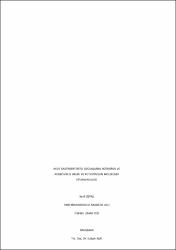| dc.contributor.advisor | Aşık, Gülşah | |
| dc.contributor.author | Öztaş, Sevil | |
| dc.date.accessioned | 2015-02-17T14:21:32Z | |
| dc.date.available | 2015-02-17T14:21:32Z | |
| dc.date.issued | 2014 | |
| dc.date.submitted | 2014 | |
| dc.identifier.citation | Öztaş, Sevil. Akut Gastroenteritli Çocuklarda Rotavirus Ve Adenovirus Sikliği Ve Rotavirusun Moleküler Epidemiyolojisi. Afyonkarahisar: Afyon Kocatepe Üniversitesi, 2014. | en_US |
| dc.identifier.uri | http://hdl.handle.net/11630/2097 | |
| dc.description | Bu Çalışma Afyon Kocatepe Üniversitesi Tıp Fakültesi Bilimsel Araştırma Projeleri Koordinatörlüğü Tarafından 12.SAG.BİL.13 Numaralı Proje Ile Desteklenmiştir. | en_US |
| dc.description.abstract | Enterik viruslar (özellikle rotavirus, adenovirus venörovirus) bakteriyel olmayan akut gastroenteritlerin en sık nedenidir. Bu çalışmanın amacı, 0-6 yaş akut gastroenteriti olan çocuklarda viral etyolojinin sıklığını araştırmak ve rotavirusların baskın genotiplerini belirlemektir.
Yaygın ishal virüsleri ile ilgili epidemiyolojik çalışma, Eylül 2012-Kasım 2013 döneminde Afyonkarahisar ilinde gerçekleştirilmiştir. Afyon Kocatepe Üniversitesi Hastanesi Çocuk Hastalıkları Polikliniği başvuran 6 yaşın altındaki 492 aşılanmamış ve ishali olan çocuklardan alınan dışkı örnekleri çalışma kapsamına alınmıştır. Dışkı örneklerinin tümü bakteriyel etkenlerin varlığını belirlemek amacıyla kültür yöntemleri ile değerlendirilmiş ve herhangi bir bakteriyel üreme gözlenmemiştir.Rotavirus ve adenovirus antijenleri immunokromatografik yöntem (ICT) ile araştırılmıştır (VIKIA Rota-Adeno Kaset Testi, bio-Merieux, Marcy l'Etoile, Fransa). ICT ile rotavirus pozitif bulunan dışkı örnekleri, Reverse Transkripsiyon-Polimeraz Zincir Reaksiyonu tabanlı genotipleme
Akut gastroenteritli 492 çocukta rotavirus ve adenovirus pozitifliği sırasıyla %20.3 ve %3.3 olarak bulunmuştur. Viral gastroenteritli çocukların %0.6’sında ise rotavirus–adenovirus birlikteliği saptanmıştır. Kış ve ilkbahar aylarında rotavirus antijeni pozitif olguların sayısındaartış gözlenmiştir. Rotavirus epizotlarının %73’ü yaşamın ilk iki yılında gözlenmiştir. G ve P genotiplerinin G1, G2, G4, G9 ve P[4], P[8] genotiplerini içeren toplamda altı farklı kombinasyonu bulunmuştur. En yaygın rotavirus genotipleri; G9P[8] (%48.7) ardından G9P[4] (%17.5) olarak bulunmuştur. G1P [8] (% 16.2), G2P [8] (% 11.2), G1P [4] (% 3.7), G4P [8] (% 2.5) diğer genotipleri oluşturmuştur. Bölgemizdeki rotavirus genotiplerinin %66’sının G9P[8] ve G9P[4] olduğu gözlenmiştir.
Adenovirus pozitifliğinin sıklığı rotavirustan daha düşüktür. Rotavirus enfeksiyonunun yüksek oranlarıylaile ilgili olarak, gastroenterit önleme programları hakkında bilgilendirmenin yanı sırayeni rotavirus suşların ortaya çıkması hakkında bilgi sağlamak amacıyla sürekli izlem gereklidir. Bu durum aynı zamanda, rotavirus aşısı yapımında karar verme politikalarına da yardımcı olacaktır. | en_US |
| dc.description.abstract | Enteric viruses (especially Rotavirus, Norovirus and Adenovirus) are the most common causes of non-bacterial acute gastroenteritis. Aim of this study was to investigate the prevalence of the viral etiology of the gastroenteritis in children aged 0-6 years with acute gastroenteritis and determine predominant genotypes of Rotaviruses.
An epidemiological study on common diarrheal viruses was carried out in province of Afyonkarahisar, Turkey, during September 2012-November 2013. Fecal samples obtained from the 492 unvaccinated children with rotavirus vaccine and under 6 years of age who applied to the Pediatric Diseases Outpatient of Afyon Kocatepe University Hospital with the complaint of diarrhea were enrolled into the study. All the fecal samples were evaluated in order to determine presence of the bacterial agents by using bacteriological culture methods and finally no growth observed. Rotavirus and Adenovirus antigens were examined by immunochromatographic method (ICT) (VIKIA Rota-Adeno Casette Test, bio-Merieux, Marcy l’Etoile, France) in stool samples.Rotavirus positive Stool samples with ICT were subjected to Reverse Transcription-Polymerase Chain Reaction based genotyping of the outer capsid antigens, VP7 and VP4, determining G and P type specificities, respectively.
Adenoviruses and Rotavirus were found to be positive in 3.3 %, and 20.3 % of 492 children with acute gastroenteritis respectively. Of the children with viral gastroenteritis, 0.6 % had a mixed adenovirus-rotavirus infection.An increase in the number of cases with rotavirus antigen-positivity was detected in winter and spring months. Of the Rotavirus episodes, 73.0 % were occured during the first two years of life.A total of six different combinations of G and P types were found that included those with combinations of G1, G2, G4, G9 and P[4], P[8] genotypes. The most common rotavirus genotypes were G9P[8] (48.7 %), followed by G9P[4] (17.5 %). Other strains were G1P[8] (16.2 %), G2P[8] (11.2 %), G1P[4] (3.7 %), G4P[8] (2.5 %). Sixty-six percent of our regional rotavirus genotypes were G9P[8] and G9P[4].
The frequency of the positivity of adenovirus was lower than rotavirus. Regarding high frequency rotavirus infection, continuous surveillance is needed in order to inform gastroenteritis prevention programs as well as to provide information about the occurrence of new rotavirus strains. This will assist policy makers in decision making on rotavirus vaccination. | en_US |
| dc.language.iso | tr | |
| dc.publisher | Afyon Kocatepe Üniversitesi, Sağlık Bilimleri Enstitüsü | en_US |
| dc.rights | info:eu-repo/semantics/openAccess | en_US |
| dc.subject | Adenovirus | en_US |
| dc.subject | Akut Gastroenterit | en_US |
| dc.subject | Genotiplendirme | en_US |
| dc.subject | Rotavirus | en_US |
| dc.title | Akut Gastroenteritli Çocuklarda Rotavirus Ve Adenovirus Sikliği Ve Rotavirusun Moleküler Epidemiyolojisi | en_US |
| dc.title.alternative | Determinaton Of The Frequency Of Rotavirus And Adenovirus In Children Withacutegastroenteritis And Molecularepidemiology Of Rotavirus | en_US |
| dc.type | Master Thesis | |
| dc.department | AKÜ, Sağlık Bilimleri Enstitüsü, Temel Tıp Bilimleri Bölümü | |
| dc.relation.publicationcategory | Tez | en_US |
| dc.identifier.yoktezid | 361241 | |



















